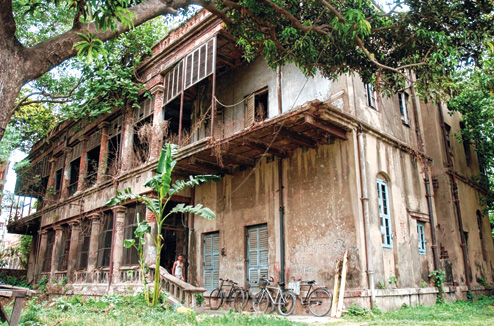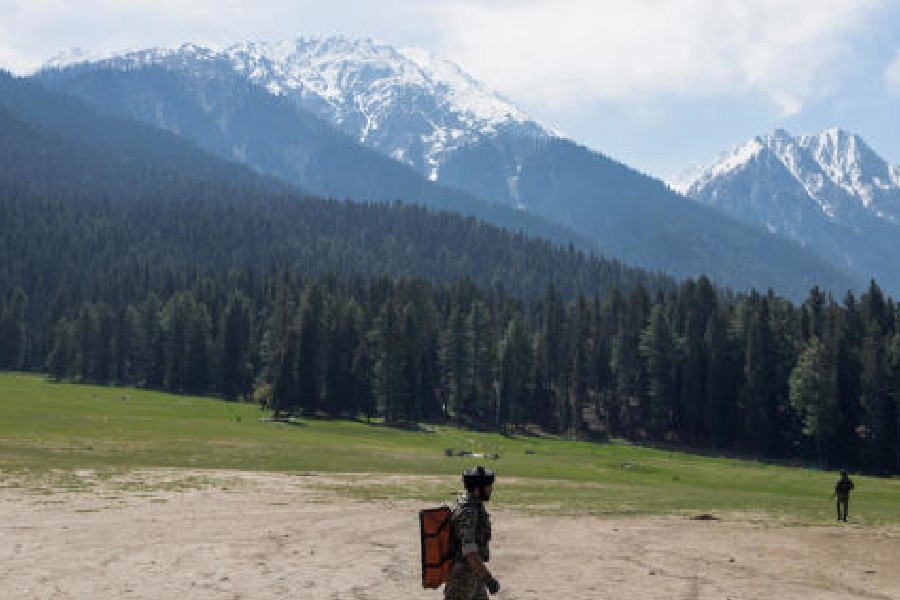 |
| The dilapidated house where Abanindranth Tagore lived. Picture by Pradip Sanyal |
Gupta Nibas, the garden house in Belgharia a little ahead of Dunlop railway bridge where Abanindranath Tagore died in 1951, will be turned into a museum by the Indian Statistical Institute (ISI), which owns the plot on which stands the dilapidated building.
The large house on the Barrackpore Trunk Road originally belonged to one of the many branches of the family of Dr Dwarkanath Gooptu of Jorasanko and is still known as Gupta Nibas, although it has been in the ISI’s possession for a long time.
Of late a high wall has been erected around the entire plot but earlier local boys used to play football on its grounds. Adjacent to it is a huge pond. It is a double-storeyed building with wide louvred verandahs running along the south side on both floors.
The first floor and terrace are held aloft by rows of six pillars on each floor. This is the closest that Gupta Nibas comes to the ancestral seat of the Tagores in Jorasanko with its famous “dakshiner baranda”, or southern verandah, where Rabindranath, Abanindranath and Gaganendranath spent their time. Rabindranath had named the house “Ghargharia” as trains chugged past it.
The ISI has signed an agreement with the National Buildings Construction Corporation, a government of India enterprise, to restore Gupta Nibas and build a cryptology centre, office buildings, staff quarters and a hostel on the plot, according to a source in the corporation. Gupta Nibas will be upgraded and restored, the source said.
Parasites have grown all over the building in ruins. Work will probably begin in the first week of July, and it will take about six months. The ISI is on the lookout for a museologist or art historian for the proposed museum.
House No. 5 Dwarkanath Tagore Lane in Jorasanko was demolished in 1941, following Rabindranath’s death, when his nephew, Abanindranath, rented Gupta Nibas where his family sought refuge in the same year.
Abanindranath’s wife, Suhasini, died there in 1942. Amitendranath Tagore, son of Abanindranath’s eldest son, Alokendra, had said in an earlier interview that “the man who wrote pictures” had painted a fresco of Shiva’s family in the Himalayas on a wall of Gupta Nibas. The painting was later washed away during monsoon.
Asked on Wednesday whether he was happy with the ISI’s decision, Alokendra Tagore replied in the affirmative but expressed surprise that the ISI had not conveyed the message to him.
Abanindranath finished his last book, Khuddur Jatra, in Gupta Nibas and during his stay many distinguished visitors dropped by. The very next year he moved to Santiniketan as vice-chancellor, where he stayed for four years and returned, thereafter, to Gupta Nibas. He lived here till his death in 1951 along with his sons and great grandchildren.
Prasanta Chandra Mahalanobis, who had established the ISI, lived there for some time when Rabindranath stayed there as his guest. Mahalanobis had rented it in the 1930s.
Mitendra Gangopadhyay, the son of statistician Mohanlal Gangopadhyay, who had written Dakshiner Baranda and was Abanindranath’s grandson, lived in Gupta Nibas as a child. Mohanlal started living there from 1947.
According to Mitendra, the garden house was constructed on a sprawling plot, part of which is a housing colony named Tagore Park now. It had three ponds and the southern verandah was 50ft by 15ft. Mohanlal lived there with his wife Milada, a Czech, son Mitendra and daughter Urmila. A couple, Bhupendra Chandra Das, and his American wife, who had started the biometry section in the ISI also lived there.
The 32-bigha garden had many fruit trees and three lawns. Later this was divided into three sections. The ISI had acquired 20 bighas and the Garden Reach Workshop, four bighas.
After Abanindranath’s death, his family continued to live there till their tenancy contract ended around 1958, when the government acquired it. But Mohanlal and his family continued to live there as he was employed with the ISI and was allotted a flat in Gupta Nibas as his quarters.
He died in 1969 and according to Mitendra, they left the house in 1972. The building was abandoned thereafter.











